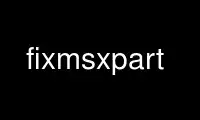
This is the command fixmsxpart that can be run in the OnWorks free hosting provider using one of our multiple free online workstations such as Ubuntu Online, Fedora Online, Windows online emulator or MAC OS online emulator
PROGRAM:
NAME
fixmsxpart - corrects note spacing in a single-staff MusiXTeX part
SYNOPSIS
fixmsxpart [-v | --version | -h | --help]
fixmsxpart [-d | --debug] infile[.tex] [outfile[.tex]]
Converts a single-staff MusiXTeX part (possibly derived from a multi-instrument score and
as a result having irregular note spacing) to a single-staff part with proper spacing
determined by the notes themselves.
If outfile is not specifed, standard output is used.
USAGE
Generating a Single-Instrument Part
To generate a single-instrument part from (a copy of) the MusiXTeX source for a multi-
instrument score, add
\input musixtnt
to the preamble, set
\instrumentnumber1
and use the \TransformNotes macro defined in musixtnt.tex to discard all but one part.
For example, the following line placed after \startpiece (but before any note commands)
would be appropriate for a four-instrument score (arguments #2, #3, #4, and #5, separated
by three &s), and will result in a part for the second of these (#3):
\TransformNotes{#2}{#3}
Argument #1 is a scaling parameter and should not be modified. It is essential that every
\znotes, \notes, \Notes, \NOtes, etc. command in the score match the macro pattern
exactly; insufficient (or too many) note segments will result in lost text and possibly
compilation failure; see msxlint(1). It is assumed by \TransformNotes that notes commands
are terminated by \en (rather than \enotes).
Some additional manual changes to the source will be necessary:
+ adjustments of \setname1, \setclef1, \setsign1 , \setmeter1 and \setstaffs1 commands,
as necessary;
+ ensuring that tempo and roadmap markings (D.C., Fine, etc.) are in the appropriate
instrument segment;
Finally, if the modified score is compiled and viewed, it may be seen that horizontal
spacing designed for multiple instruments often produces bad spacing for a single
instrument. This can be corrected manually (and very tediously) but it is what fixmsxpart
was designed to fix (much more conveniently).
Correcting Horizontal Spacing Using fixmsxpart
The \notes \Notes \NOtes \NOTes... commands in a part derived from a multi-instrument
score are unreliable, and so fixmsxpart determines the spacing for ordinary notes by the
note commands themselves; for example,
+ \qa, \qu, \ql, \qp result in \NOtes;
+ \ca, \cu, \cl, \ds result in \Notes;
and so on. Spacing commands \sk and \hsk in the input are discarded (but \qsk, \hqsk and
explicit uses of \off{...} are preserved).
fixmsxpart determines the spacing for beamed notes by the beam multiplicity: \ib...
results in \Notes, \ibb... results in \notes, etc. Some beam-termination commands (\tb...)
are problematic because the immediately-following beam note \qb... must be spaced
according to the spacing before the \tb... command. This is handled by setting a variable
new_beaming when processing the \tb... command and only updating beaming to new_beaming
when processing the subsequent beam note. This isn't needed for the abbreviations \tqb,
\tqh, \ztqb and \ztqh which combine beam-termination and specification of the final beam
note.
Pointed notes are not given extra space automatically. They should be given extra space
manually in the score by using either a \roff-like command on the subsequent note or the
\qsk or \hqsk spacing commands.
Additional features of fixmsxpart transformation:
+ Successive whole-bar rests are accumulated into a multi-bar rest, with appropriate
adjustment of the bar number.
+ \alaligne and \alapage commands are replaced by \bar.
+ \mulooseness, \eject, \linegoal, \song{top | bottom}, \group{top | bottom} and
\akkoladen commands are commented out.
+ \instrumentnumber... commands become \instrumentnumber1.
+ \nostartrule is added to the preamble.
+ Simple slurs or ties initiated by \slur or \tie are normalized by setting the n
parameter to 1 on the assumption that the new note spacing is correct.
LIMITATIONS
Only single-staff instrumental parts are supported. User-defined macros are not expanded.
A few esoteric MusiXTeX commands and constructions are not supported.
Use fixmsxpart online using onworks.net services
